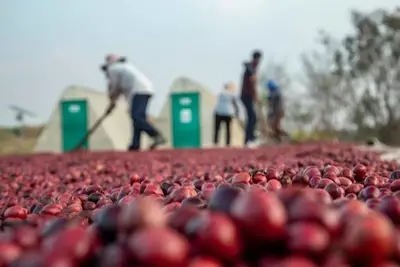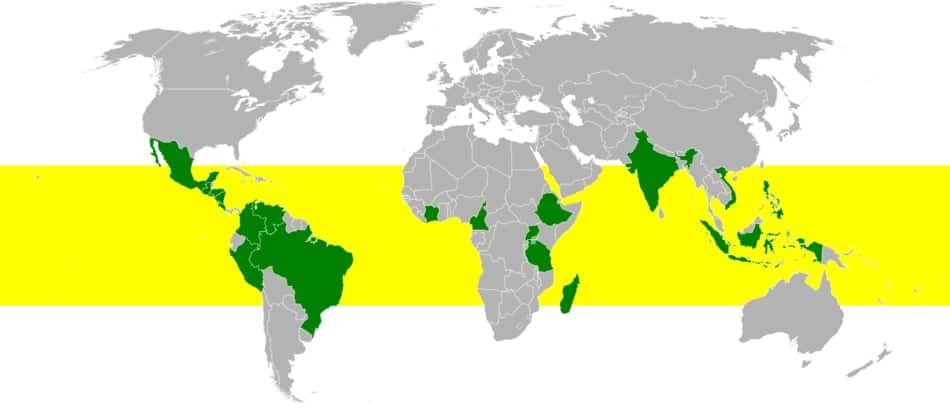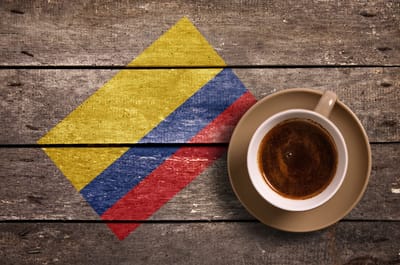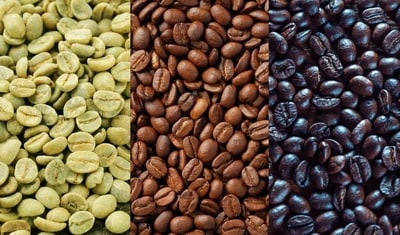Coffee Production 101: How Is Coffee Produced & Processed?
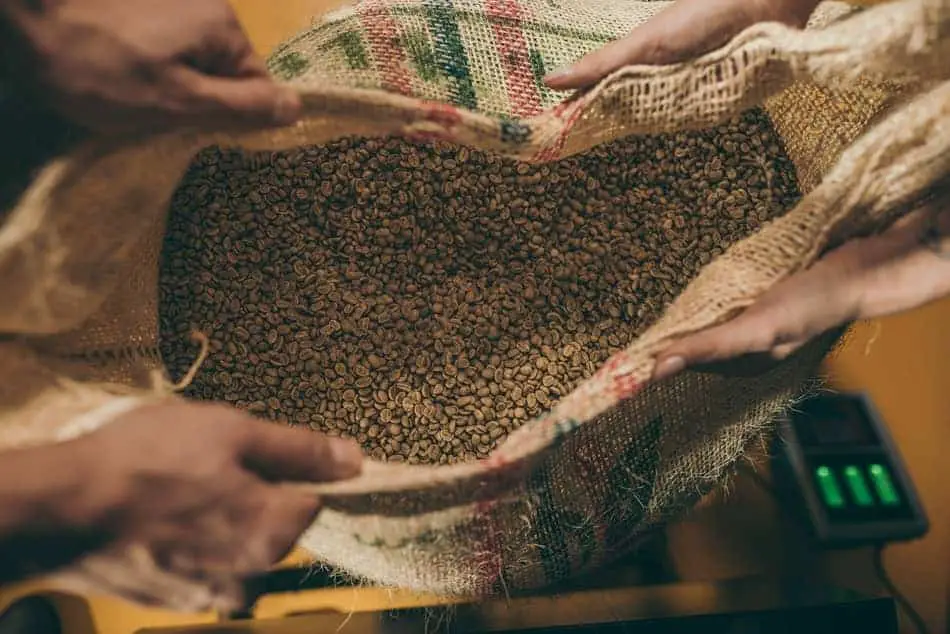
Global coffee production reached more than 11 million tons last year, providing us with more than two billion cups of coffee. Here, we take a detailed look at every step along a coffee’s journey from seed in the ground to a freshly brewed cup of coffee in your hands.
From seed to cup, there are 11 stages:
- Planting
- Harvesting
- Processing
- Drying
- Resting
- Milling
- Grading and sorting
- Exportation
- Quality testing
- Roasting
- Grinding and brewing
What we know as coffee beans are actually the seeds from the fruit of the coffee plant. It’s here that the world’s coffee starts its fascinating journey.
1. Planting
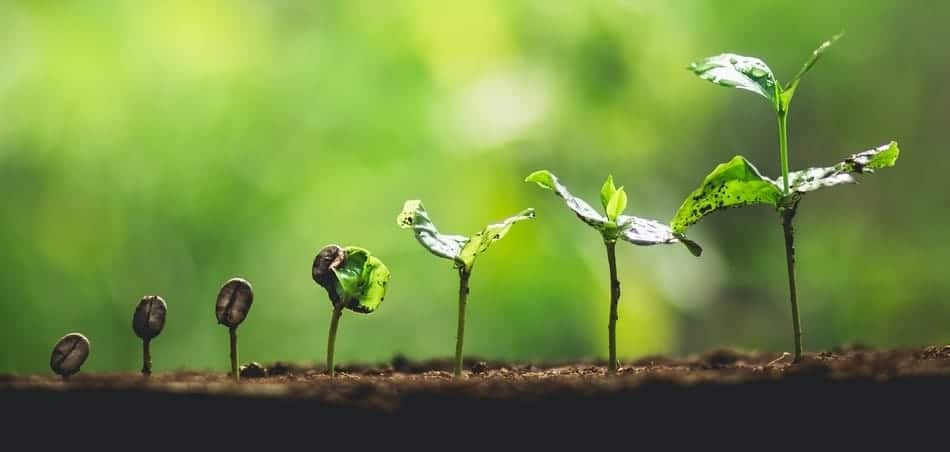
Seeds (unroasted coffee beans) are planted in shaded rows to protect them from too much exposure to the sun. Fresh seeds germinate about two and a half months after planting, but older seeds may take as long as six months.[1]
Despite there being over 100 species of coffee plant, the world’s coffee is made up of just three species. The arabica species makes up 60 – 70 percent, 30 – 40 percent is made up of the robusta species, and less than two percent is from the liberica species.
The majority of the world’s coffee is grown within what is known as the coffee bean belt. The coffee belt is located between the Tropics of Cancer and Capricorn, spanning some 3200 miles (5100km) from north to south.
For best results, coffee plants should ideally be planted in areas that are hilly with volcanic soil that is rich in nitrogen. Arabica grows more slowly and is more costly to produce; however, it produces a vastly superior cup of coffee.
Coffee is planted at elevation because the temperature is cooler and more stable at altitude. The arabica variety has to be planted at higher altitudes than robusta, around 1000 – 2000m (3300 – 6600ft) above sea level. Ideal temperatures for arabica are between 15 to 25ºC (59 – 77ºF).[2]
Robusta is generally grown at lower altitudes, from 200 – 600m (650 – 2000ft), but it’s even able to grow at sea level. Because robusta is hardier than arabica, it prefers higher temperatures between 20 – 30ºC (68 – 86ºF).
Arabica coffee needs an annual rainfall of 1500 – 2500mm (60 – 100in), and robusta needs 2000mm – 3000mm (80 – 120in). It’s important to have a distinct wet season for growing the coffee and a dry season for harvesting the coffee cherries.[1]
2. Harvesting
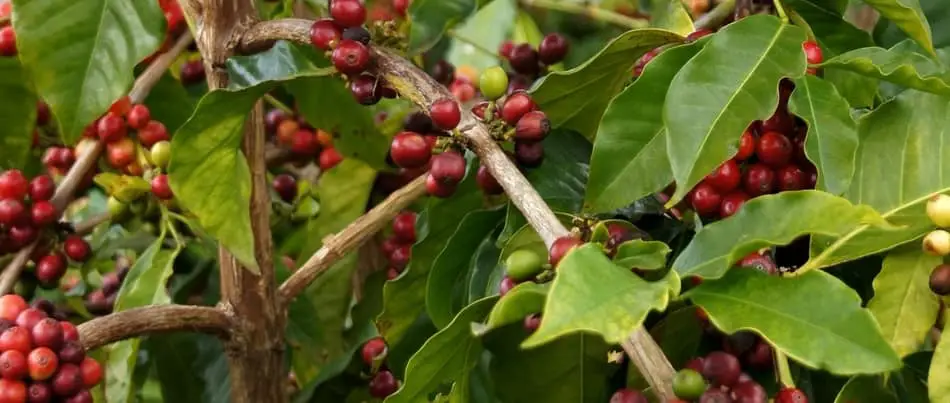
When a coffee tree reaches maturity, it begins to bear fruit in clusters along its branches. The fruit is known as a coffee cherry due to its resemblance to normal cherries. The coffee cherry is initially green and turns to red, yellow or orange when it has matured and is ready for harvesting.[3]
The first harvest of a coffee plant is usually around five years after planting. Coffee is usually harvested only once a year during the dry season; however, some countries do produce a second, smaller harvest such as Colombia’s mitaca harvest.[4]
In countries where there are no distinct wet and dry seasons, such as in Kenya, there will be two flowerings and harvests per year. The first harvest will be the main harvest and the second, which is known as its ‘fly’ crop, will be a lot smaller.[3]
Harvesting takes place north of the equator between the months of September to March. South of the equator, the harvest is from April to August.
Coffee is picked mostly by hand or with the aid of a mechanical stripper. In some lands, machines are used to harvest the coffee cherries.
Selective picking by hand
Although picking coffee cherries one-by-one by hand is very labour intensive, it produces the best quality coffees. Pickers go out into the farms with baskets hung around their waists, ideally looking to pick only the ripest coffee cherries.

Picking unripe cherries results in an inferior cup of coffee as the sugars in the fruit haven’t had chance to fully develop, which greatly affects the beans housed inside. As you know, a piece of fruit that hasn’t ripened fully is unpleasantly sour and not enjoyable to eat.
Once a picker’s basket is filled with cherries, they will empty their basket into large collection bags. At the end of each day, these large collection bags are emptied, sorted of any debris and then weighed. The picker is then paid according to how much they picked that day.
Unfortunately, due to the fact that most pickers are poor and paid by weight, pickers collect unripe cherries to boost earnings. Specialty coffee farmers incentivise their pickers to select only the ripest cherries to produce superior coffee, rewarding them accordingly with better rates of pay.
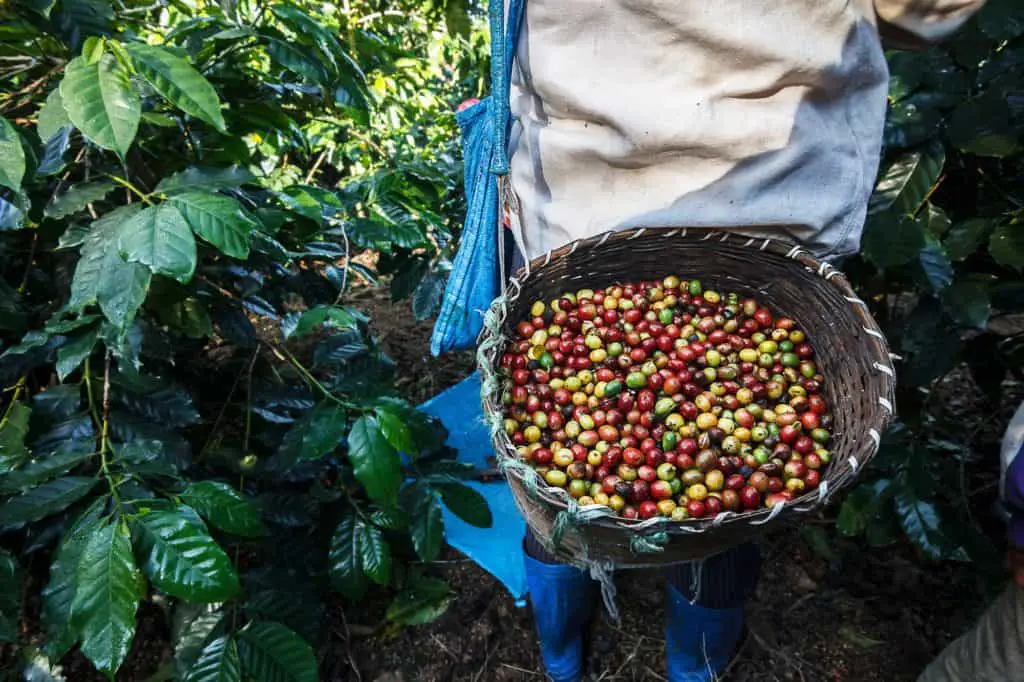
On average, pickers are able to gather between 45 – 90kg (100 – 200lbs) of cherries per day, which produces 9 – 18kg (20 – 40lbs) of coffee beans.[5]
Strip harvesting is one manual alternative to picking cherries one-by-one. Firstly, the picker will lay canvas below the coffee plant, and then the picker will then grab onto one of the branches of the coffee plant and pull downwards, stripping all of the cherries in one go.
Another alternative to manual harvesting is with the use of a mechanical stripper known as a derriçadeira. The fingers run through the branches of the coffee plants, collecting the falling cherries onto the canvas.[6]
Again, this method produces an inferior end product due to the mix of under- and over-ripe cherries. Many commercial grade coffee producers use this method for low-grade coffee as it is much less labour intensive.
Strip harvesting by machine
In countries such as Brazil, where the immense landscapes are relatively flat, the harvesting process is able to be undertaken using an agricultural machine.
Most countries are not able to use machines to harvest their coffees due to the fact that the coffee is grown in hilly areas where machines cannot pass.
The machine runs through each row of the coffee plant, straddling them whilst using vibration to shake and strip the cherries from the branches.
Although this is an enormous time-saver, it does come at a cost. As well as the cost of running the machines, a lot of the under-ripe coffee cherries also go to waste, affecting the farmer’s profits.
Extra care is also needed during the sorting, pulping and drying processes post-harvest because of the assortment of under- and over-ripe cherries.[6]
3. Processing
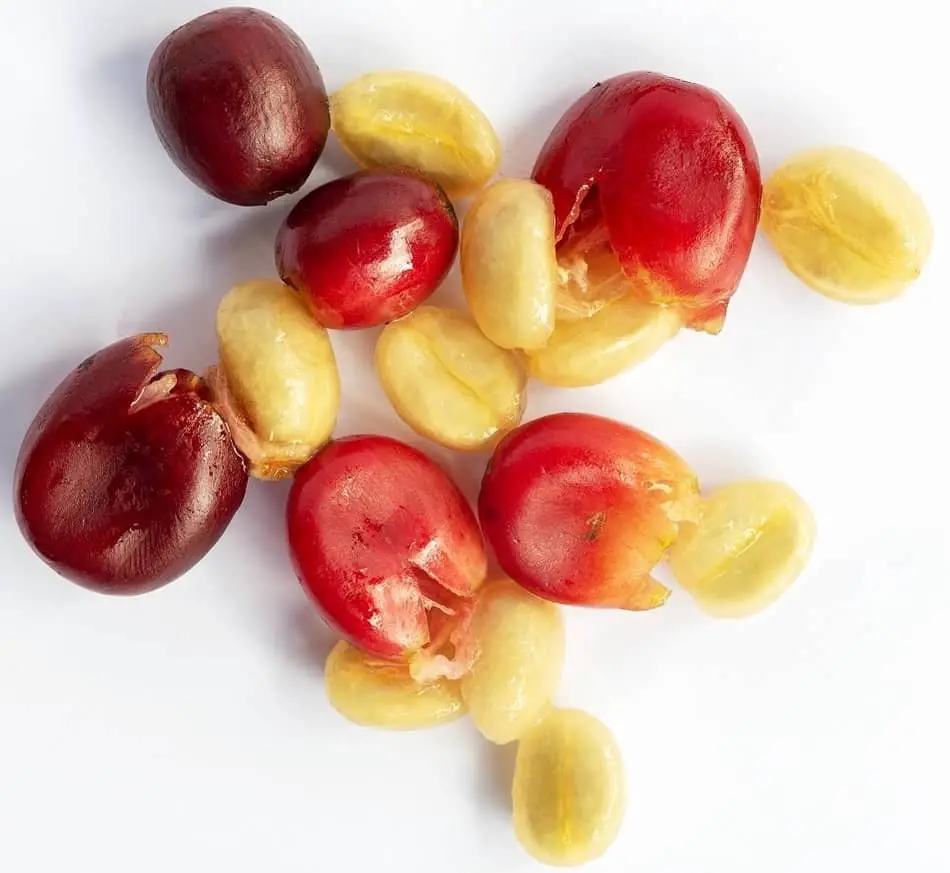
Coffee is processed in one of three ways:
- Washed-processed, also known as the wet process.
- Naturally-processed, also known as the dry process.
- Honey-processed, also known as the semi-washed process.
In today’s world, processed food has negative connotations. However, when we speak of processing coffee, it is nothing more than the act of extracting the beans from the coffee cherry fruit so that it can be prepared for roasting.
As the wording suggests, the wet process requires the use of water whereas the dry process does not. Semi-washed is a hybrid of the two methods, requiring water but in lesser amounts.[7]
The processing method that is chosen depends on factors such as the farmers’ financial situation, the year’s rainfall and humidity levels, and if there is access to clean, running water. As such, many African coffees are naturally-processed (dry-processed) due to a shortage of water.
In the specialty industry, washed coffees are the most highly prized as they reflect more the terroir of the coffee. Washed coffees also display more acidity, something which is also an indicator of good coffee.
Natural-processed coffees tend to be sweeter and heavier with funkier berry-fruit flavours, often described as having a boozy, wine-like quality.
Washed process (wet process)
Processing the coffee needs to take place the same day as harvesting. The coffee cherries are sent to have the outer fruit skin removed typically within eight to 12 hours of harvesting. The removal of the outer fruit layer is known as depulping.
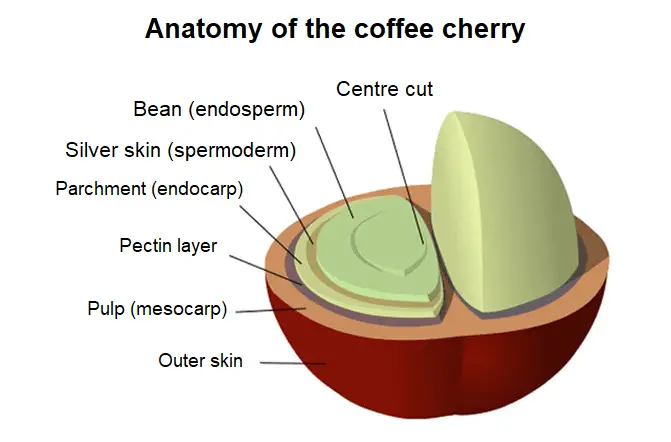
Depulping
The aim of the depulping process is to remove the outer skin and pulp (mesocarp) of the coffee cherry, extracting the coffee beans housed inside the cherry.[8]
Depulping is carried out either by the use of a depulping machine or by leaving the cherries to soak in water for one to two days, whereby the natural chemical process that takes place pulls the pulp flesh away from the beans.
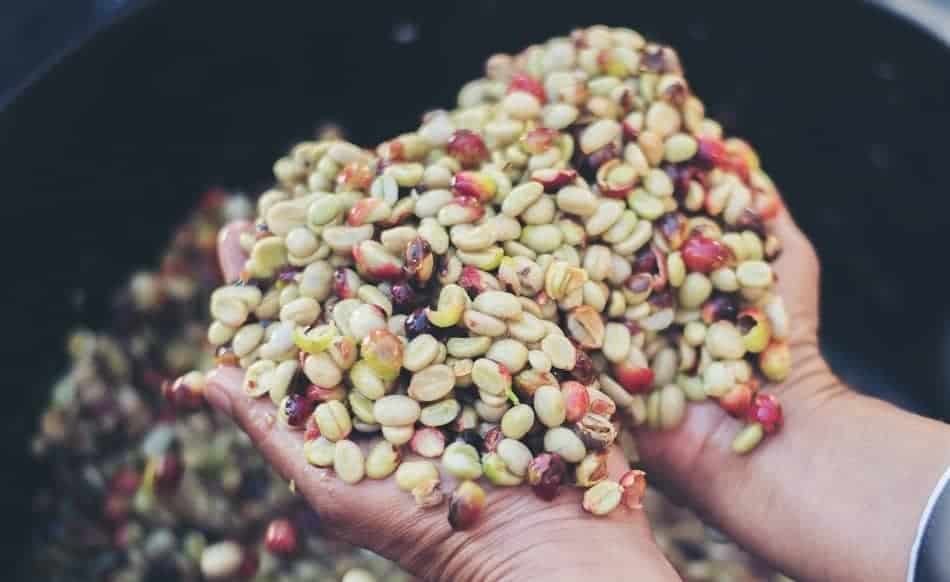
The latter method of soaking the beans is known as the fully washed process whereas the use of a mechanical depulper is only known as the washed process. Depulping machines are either motorized or manually operated.
The beans now go onto vibrating screens that separate them from any unpulped or inadequately pulped cherries.
From the screens, the separated beans pass through water-washing channels where a further flotation separation takes place before they are sent to the next stage of fermentation.[9]
Fermentation
The mucilage that covers the outside of the coffee beans now needs to be removed by way of fermentation. Fermentation creates an environment of enzymatic activity that breaks down the mucilage, softening it so that it can more easily be removed later through washing.
The fermentation process is a delicate operation, requiring constant monitoring to ensure that the coffee is not negatively affected by over-fermentation.
The depulped beans are sent to fermentation tanks where they are fermented either aerobically (with oxygen) or anaerobically (without oxygen).
Aerobic processing is most common, and the process takes between 12 – 36 hours to complete, depending on the temperature, thickness of the mucilage layer and concentration of the enzymes. The process is quicker and less costly than anaerobic processing, but over-fermentation is of greater risk.
Anaerobic fermentation takes 96 hours or longer to complete. The tanks are depleted of oxygen either through a one-way valve or by submerging the beans in water.
The anaerobic process gives the farmer greater control over the fermentation, and it also serves to create different flavours which are not possible through aerobic fermentation.[10]
The end of the fermentation is assessed by feel, as the parchment surrounding the beans loses its slimy texture, acquiring a ‘pebbly’ feel that’s rough to the touch.[11]
Once fermentation has taken place, the beans are washed in clean water inside tanks or special washing machines. The farmer agitates the beans to remove the mucilage, leaving the beans clean inside their parchment layer in preparation for drying.
During the cleaning process, the farmer scoops off any beans that float on the surface of the water as this is a sign that they are damaged or defective. These beans will either be discarded or used for low-grade coffee, known in Latin American countries as segundas (Spanish/Portuguese, ‘seconds’).
The mucilage that is removed from the beans causes the water to become murky, and so the farmer has to change the water inside the tank several times. The water containing the mucilage needs to be filtered or carefully disposed of to avoid contaminating fresh water sources.
Now that the coffee has been washed of its surrounding mucilage layer, the coffee has to be rapidly dried. We’ll discuss the drying process after looking at the remaining two processing methods.
Natural process (dry process)
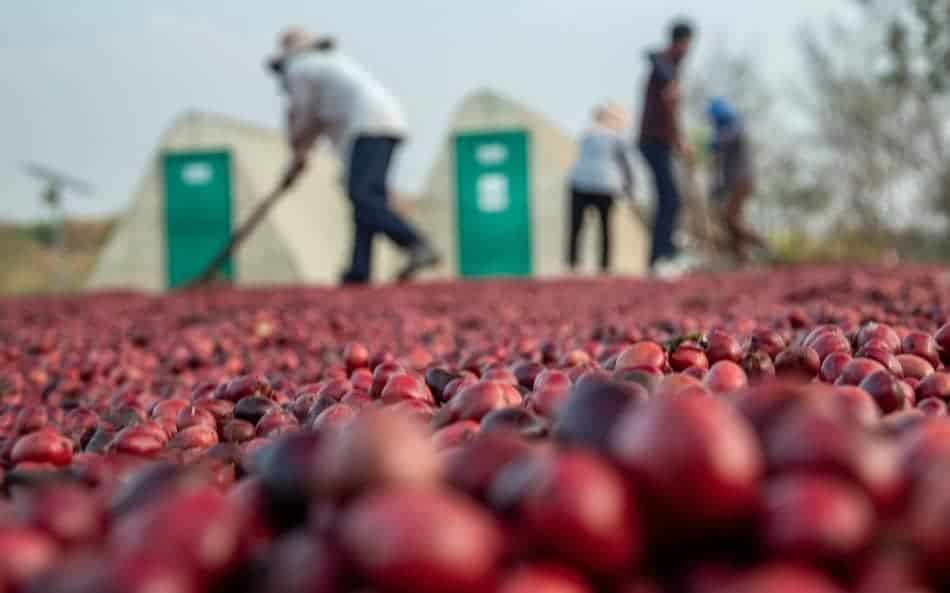
The natural process, also known as the dry process, is the oldest type of processing for coffee. The outer skin and pulp of the cherries are not removed from the beans as with the washed process.
Instead, the whole cherries are left intact to dry and ferment together with the beans inside. This is the same process that’s used for turning grapes into raisins.
Naturally-processed coffee is the simplest form of processing and the least labour intensive. Despite the process not requiring as many steps as with the washed process, the farmer still needs to ensure that the coffee cherries are handled with care so that they do not spoil.
The natural process is used in regions where there is low rainfall, low humidity and where access to fresh water is scarce. Unlike most other Latin American countries, 90 percent of Brazilian coffee is naturally processed.
Sorting and cleaning
Once the cherries have been harvested, they are sorted and cleaned. Cherries that are unripe, overripe or damaged are removed, as is any debris such as soil, twigs and leaves. This is most commonly carried by winnowing using a large sieve.[12]
As each cherry has a slight variance in sugar content, fermentation takes place at varying speeds. As such, it’s incredibly important that the cherries are all of a similar ripeness so that fermentation is as uniform as possible amongst the batch.13
Good quality processing stations continue to monitor and seek out defective cherries throughout the drying process to ensure quality is upheld. Let’s now look at the honey process before discussing the drying process.
Honey process (semi-washed process)
Sitting somewhere between washed and natural coffee is the semi-washed process, better known as the honey process. The process is becoming increasingly popular in Central American countries such as Costa Rica and El Salvador.
The honey coffee process is nowhere near as common as the washed and natural process due to how much care is needed to correctly carry out the process.
The outer skin and varying levels of the pulp flesh of the cherries are removed by depulpers.
The honey process has its origins in a process known as pulped natural. The pulped natural process originated in Brazil in the 1970s as a way to conserve water and speed up the drying process, increasing production and profits.[14]
The honey process comes in five varieties, which are defined by colour. The most common varieties are yellow honey, red honey and black honey. Somewhat less common is white honey and gold honey.
Depulping
The coffee cherries are sent to a depulper to remove the outer skin, but varying levels of pulp are intentionally left surrounding the beans.
White and yellow honey coffees have almost all of the mucilage removed and so are most like a washed coffee.
White honey coffees tend to be mechanically washed, leaving very little mucilage behind.
Yellow honey coffees are often semi-washed, with slightly more mucilage typically being left surrounding the bean.
Gold and red honey coffee have around half of the mucilage removed.
The black honey process only removes the skin and pulp, leaving behind 100 percent of the mucilage. Black honey coffees are most like natural coffees in their characteristics.
Honey varieties
The amount of mucilage that covers the bean is one way that determines whether the beans are classified as white, yellow, gold, red or black.
An alternative way of defining the honey colour is based on the method of drying. The speed at which the beans are dried, the amount of sunlight the beans are exposed to, and the type of enclosure or surface the beans are kept in all define the colour of the beans.
Beans that are dried more quickly with little humidity are lighter in flavour and their appearance is white or yellow. Beans that are dried more slowly with more humidity produce heavier flavours with a gold, red or black colour.
After stripping the fruit covering, the beans are laid out to dry. White and yellow honey coffees are laid out on patios in a thin layer to enable fast, even drying.
For gold, red and black honey coffees, the beans are stored inside greenhouses in deep piles for a slower fermentation. As the coffee dries, the farmer will rake the coffee into thinner layers until it reaches the optimum level of 11 percent moisture content.
4. Drying
Following the processing of the coffee beans, they have to be dried. After the coffee has been processed, it has a moisture content of around 45 – 60 percent. This needs to be lowered to between 10 – 12 percent to avoid spoilage caused by mould forming amongst the moist beans.
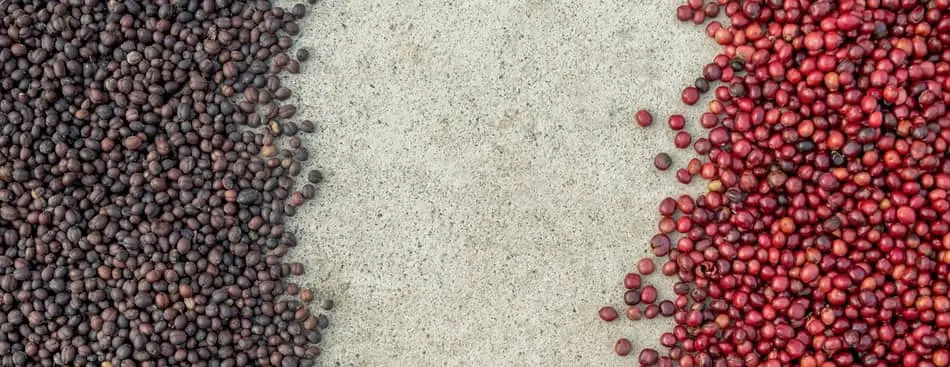
A study carried out in Kenya reported that there are six stages to drying coffee.[15]
- Skin drying. Moisture 55 – 45 percent.
- White Stage drying. Moisture 44 – 33 percent.
- Soft Black stage. Moisture 32 – 22 percent.
- Medium Black Stage. Moisture 21 – 16 percent.
- Hard Black Stage. Moisture 15 – 12 percent.
- Fully dry coffee and conditioning. Moisture 11 – 10 percent.
Coffee beans can either be dried in the sun or by machine. In most cases, the coffee beans are dried in the sun until they reach a moisture content between 11 – 12 percent. Once they reach this stage, the beans are transferred to mechanical driers to bring the content down to 10 percent.
There are three main methods used to dry the cherries, which are patios, raised beds or mechanical dryers. Drying entirely by machine is usually only carried out when space is at a premium or the humidity is too high for the beans to dry.
Patios
The cherries are laid out in rows on clay or cement-tiled patios in piles 8 – 15cm (3 – 5in) deep. The direct heat from sunlight is absorbed by the tile, drying the cherries. To ensure uniformity, the cherries are turned every hour during the day.
Drying on patios takes 6 – 7 days for washed-processed coffee, 8 – 9 days for honey-processed coffee, and 12 – 14 days for natural-processed coffee.
Coffee beans are typically dried on patios until they reach a moisture content of 15 percent, after which they are transferred to mechanical dryers.
Raised beds
The cherries are spread in a single layer over waist-high, mesh-lined trestles in piles 2.5 – 5cm (1 – 2in) deep. The drying takes place from the direct sunlight which is aided by airflow above and below the trestle.
The cherries are turned every hour to ensure even drying. Depending on the processing method used, the process takes between 10 – 28 days to complete.
Mechanical dryers
This is the least commonly used of the three drying processes due to the cost involved. Mechanical dryers come in two varieties, vertical and horizontal.
Mechanical dryers can dry several tonnes of parchment coffee at once. They become necessary at large plantations where there is such a high volume of coffee that there is not enough space for drying in natural sunlight. They are also effective in areas with high amounts of rainfall.[12]
The parchment coffee has to first be pre-dried for 1 – 2 days on patios before it can enter the mechanical dryers. Both types of dryers use heated air which is blown around in order to dry the coffee. The coffee will spend 2 – 3 days drying inside the mechanical dryers.
Solar power
A relatively new method of drying coffee, which is not widely used, is solar-powered drying. Solar dryers are more environmentally friendly as well as more economical due to not relying on electricity or fossil fuels.[16]
5. Resting
The coffee beans now need to go through a resting period, known as reposa, before the parchment layer is removed. Depending on the storage method used, the parchment coffee can be in reposa upwards of 90 days. Resting the coffee this way improves its overall shelf life.
For correct storage, the coffee needs to be in an environment that has limited light exposure, a stable temperature and proper ventilation.
Coffee that is exposed to hot, humid air through improper storage will either not stabilize properly or will begin to reabsorb moisture.
The coffee beans are mostly stored in jute bags that are stacked on pallets in huge quantities. These towers of stacked bags can limit the air movement around the coffee.
Another storage method is large wooden silos. Facilities that use this method may have more control over the process, creating a more uniform product.
6. Milling
The first step in the milling process is known as hulling. The hulling process is carried out to remove the parchment layer that coats the coffee beans. The process also removes some of the silver skin layer beneath the parchment, too.
The hulling machine uses friction to remove the layers, but great care needs to be taken so as not to generate too much heat as it negatively impacts the quality of the coffee beans.
Now that the coffee beans have had their parchment layer removed, the only layer left surrounding the coffee beans is the silver skin. As not all of the silver skin that coats the coffee beans is entirely removed through hulling, some plantations send the coffee beans to have it removed in a process known as polishing.
Polishing improves the appearance of the green coffee beans and also eliminates the chaff that separates from the beans during roasting.[17]
7. Grading and sorting
Green coffee is sorted to remove visual defects, foreign matter and to sort the coffee beans into uniform sizes. There are several methods used to sort green coffee: colour sorting (manual or electronic) and by screen size and weight.
Sorting by colour
Manual sorting is often carried out by the wives of the farmers. Teams of workers sort through the piles of coffee beans, discarding discoloured and defective beans.
High-quality coffee beans may be sorted up to three times using this method.
Much less common is the use of electronic colour machines. These machines use special cameras to evaluate the colour of each bean by comparing it to a colour range that has been preprogrammed.
If the bean is outside of the colour range, a brief puff of air removes it from the fast-moving stream of beans flowing through the machine.[18]
Sorting by size and weight
Screen sorting runs the coffee beans through a series of sieves of different hole sizes, separating them according to size. Typically, the bean size is represented on a scale of 10 to 20, with the holes of the sieves gauged in 0.4mm (1/64in) increments.
To sort the beans by weight, they are sorted pneumatically using an air jet to separate heavy from light beans.[17]
8. Exportation
The raw, green coffee beans are now bulk-shipped inside plastic-lined containers or loaded into the containers in either jute or sisal bags.
Coffee is the second most traded commodity in the world after oil, and the coffee exportation business is worth more than $20 billion. A whopping 25 million people rely on the coffee industry to make their living.[18]19
9. Quality testing
The green coffee is now tasted and evaluated in a process known as coffee cupping. The cupping process is carried out in order to test and assess the coffee for its quality.
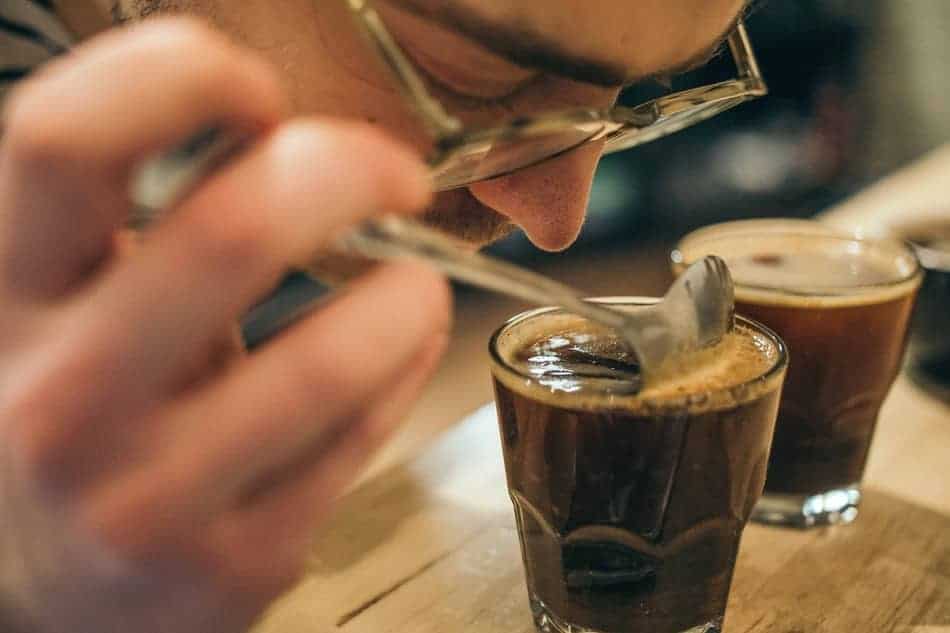
Cuppers assess the aroma, flavour, sweetness, acidity, bitterness, mouthfeel and overall balance of the coffees. The process serves to determine the price of the coffee based on its quality.[20]
First of all, the cupper visually checks the quality of the green beans by inspecting for defects and flaws.
The green beans are then roasted in small batches and immediately ground and brewed with freshly boiled water in small ramekin-like bowls that are known as cupping bowls.
The coffee is left to steep for four minutes, at which time the cupper breaks the floating coffee grounds which have formed a crust on the surface, simultaneously assessing the aroma of the coffee.
The coffee is now left for a further ten minutes or so to cool. Once sufficiently cooled, the cuppers begin sampling the coffees one-by-one, using a large convexed spoon and drawing the coffee into the mouth in a slurping motion so as to aerate the coffee, which aids tasting.
The coffee is usually spat out so as not to exhaust the palate, the same as with wine tasting. The process is repeated until the coffees are either finished or have become too cold. A professional cupper may taste hundreds of coffees per day.
10. Roasting
The process of roasting coffee is carried out in order to turn the green coffee beans that have a distinct earthy and straw-like aroma into the aromatic brown coffee beans that we all love.[21]
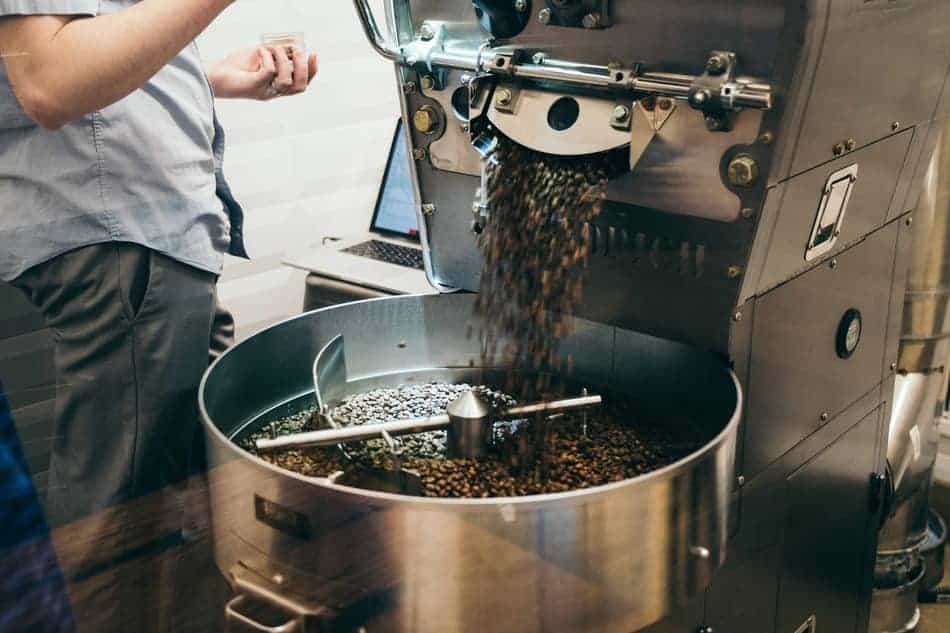
The process is carried out in dedicated coffee roasting machines, which have the capacity to roast batches weighing anywhere from 1kg (2lbs) to more than 100kg (200lbs) at a time.
Before roasting large batches, coffee roasters evaluate the beans by roasting smaller quantities, known as sample roasts. After each roast, the roaster will also cup the coffee to test the quality.
Cupping is also necessary for creating consistent coffee blends. Coffee blends need to remain consistent so that the public can enjoy the same taste year after year.
Many coffee roasters produce two different types of roast depending on whether the beans are intended for espresso preparation or filter brew preparation. Some roasters produce what’s known as an omni-roast, a type of roast profile that can be used for both espresso and filter coffees.[22]
Good quality specialty roasters pack their freshly roasted coffees in specially designed bags that have a one-way valve. The valve enables the CO2 caused by the roasting process to escape but prevents oxygen from entering and spoiling the beans.
Some roasters even go so far as to flush their bags with nitrogen to ensure the bag is entirely free of any oxygen when sealed, greatly preserving the quality of the coffee whilst also prolonging its shelf life.
11. Grinding and brewing
Approximately 35 percent of the mass of a coffee bean is soluble in water. Grinding whole bean coffee is necessary so that the water can more quickly extract the flavours.[23]
Grind size quality is extremely important when preparing coffee, so it’s important to invest in a good quality coffee grinder.

The size of the grind depends on the type of brewing method that is being used. The length of time that the water is in contact with the coffee goes towards determining the grind size, too.
As such, a very fine grind is used for espresso as brewing is completed within around 30 seconds. At the coarser end is a grind size such as that used for French press, where the water is in contact with the ground coffee anywhere from four to 15 minutes.[24]
Just as how cooking techniques such as frying, boiling, baking and poaching can all influence how a particular ingredient tastes, so the same is true with coffee.
Brewing apparatus, brew time, grind size and water temperature all have a large impact on how a particular coffee tastes.
Brewing apparatus come in many different forms. The most common are espresso machines, percolation brewers, infusion brewers and stove-top brewers.
Espresso machines come in many different sizes and varieties but are essential if you want to enjoy true espresso. Very finely ground coffee is tamped and compacted into a portafilter which is then locked into the espresso machine. Near-boiling water is forced through the bed of coffee typically at nine bars of atmospheric pressure.
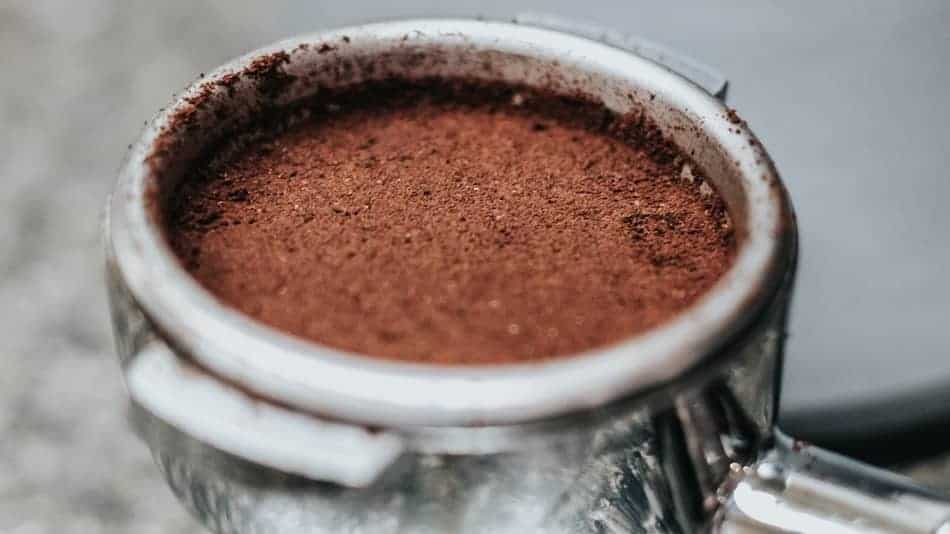
This unique brewing method produces an intensely strong coffee with a layer of crema that sits on the top of the drink. Espresso is used as the base for our much loved milky coffee drinks such as the cappuccino, latte, mocha and flat white.
Percolation, or pour-over, brewing is the act of adding the water to the ground coffee in stages until brewing is complete. Some popular percolation brewers include electronic drip machines, Chemex, Hario V60 and Kalita Wave.
Infusion, or immersion, brewing is carried out by combining all of the water with all of the coffee and leaving to steep and infuse. Some popular percolation brewers include the French press, AeroPress and Clever Dripper.
The stove-top brewer is very popular in Italian culture and is known as a moka pot. Another type of brewer that is heated on a hob is Turkish coffee.

